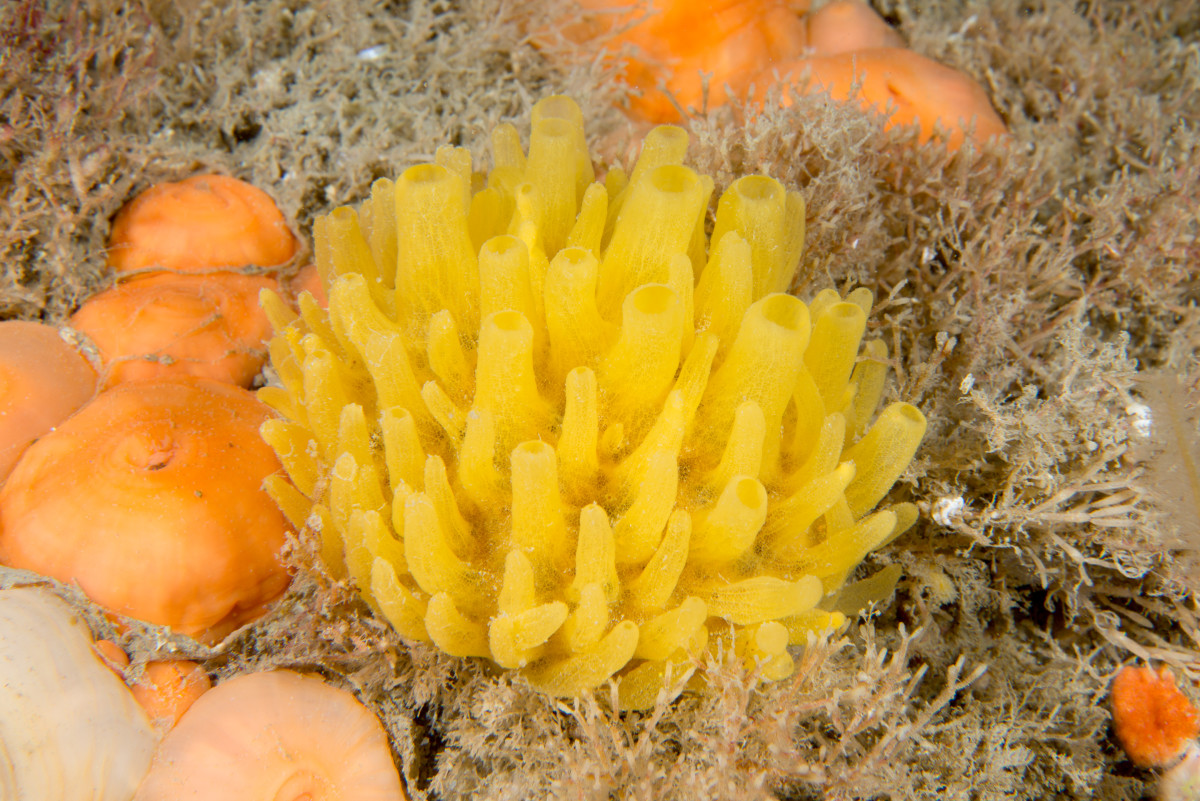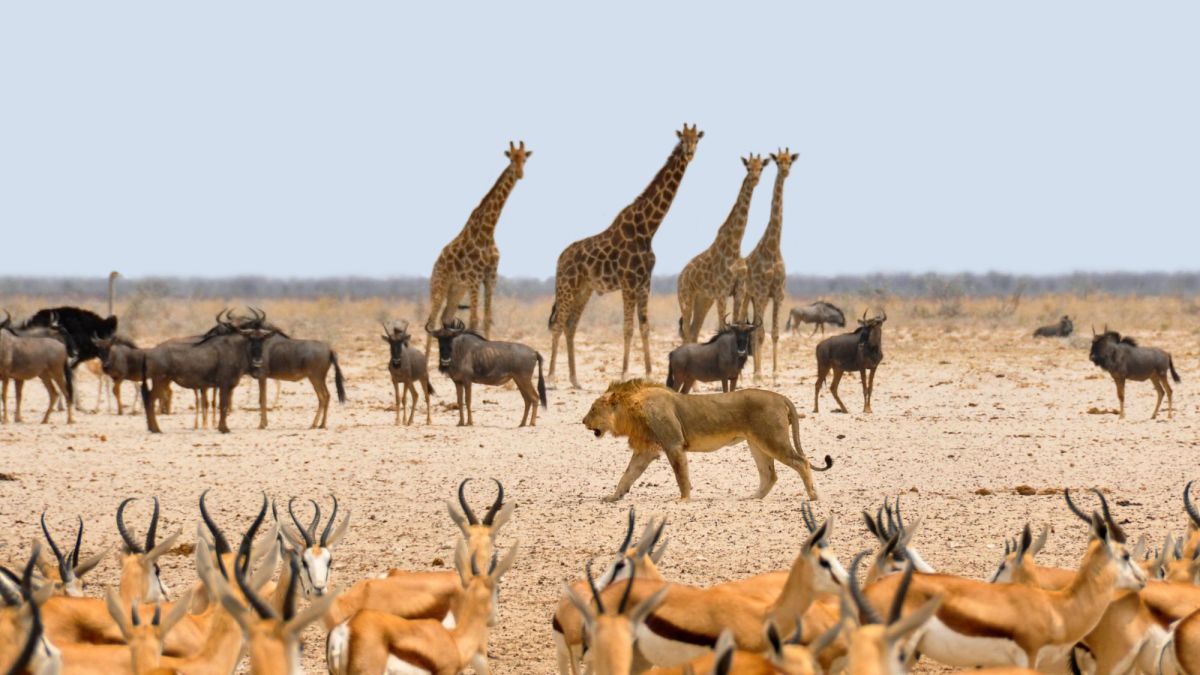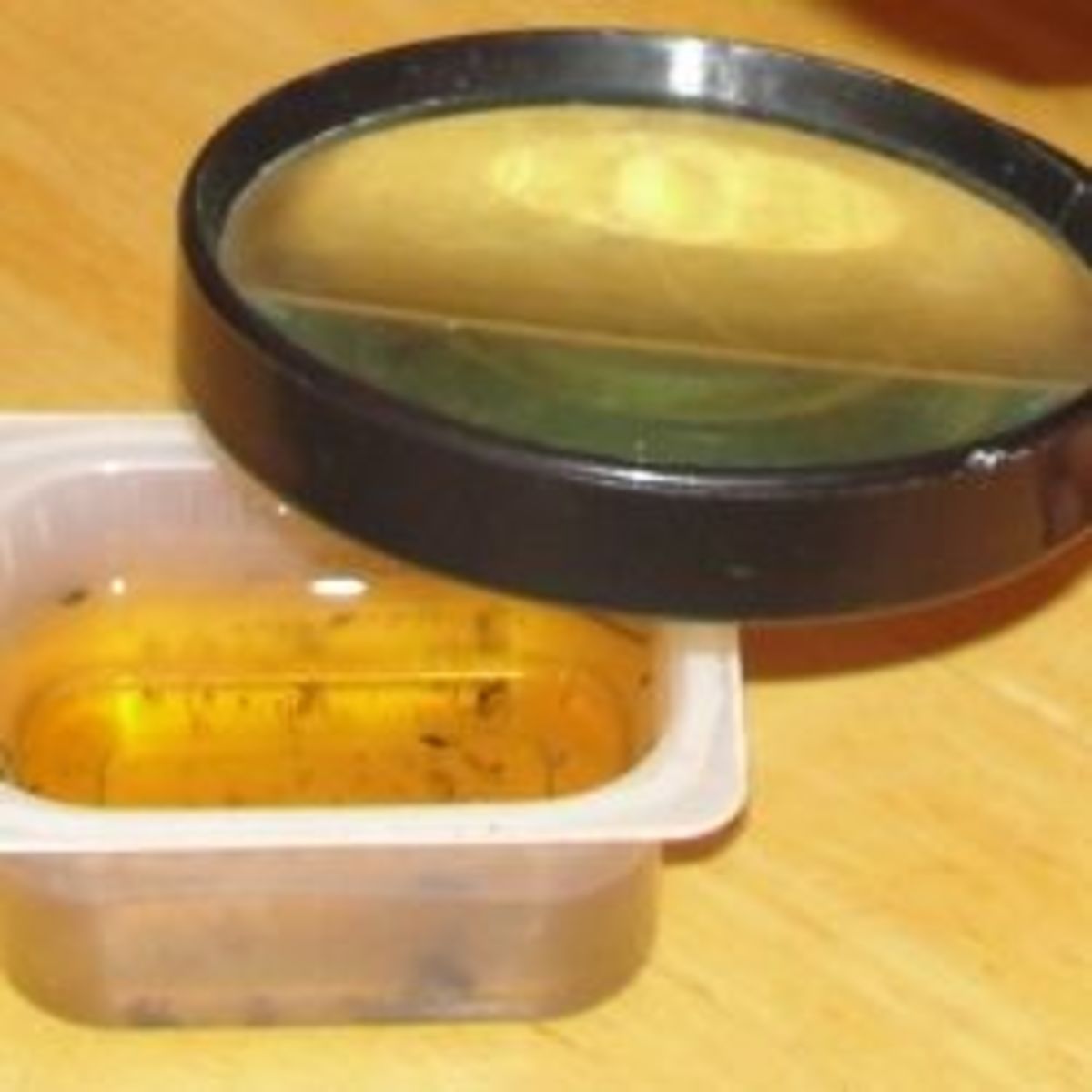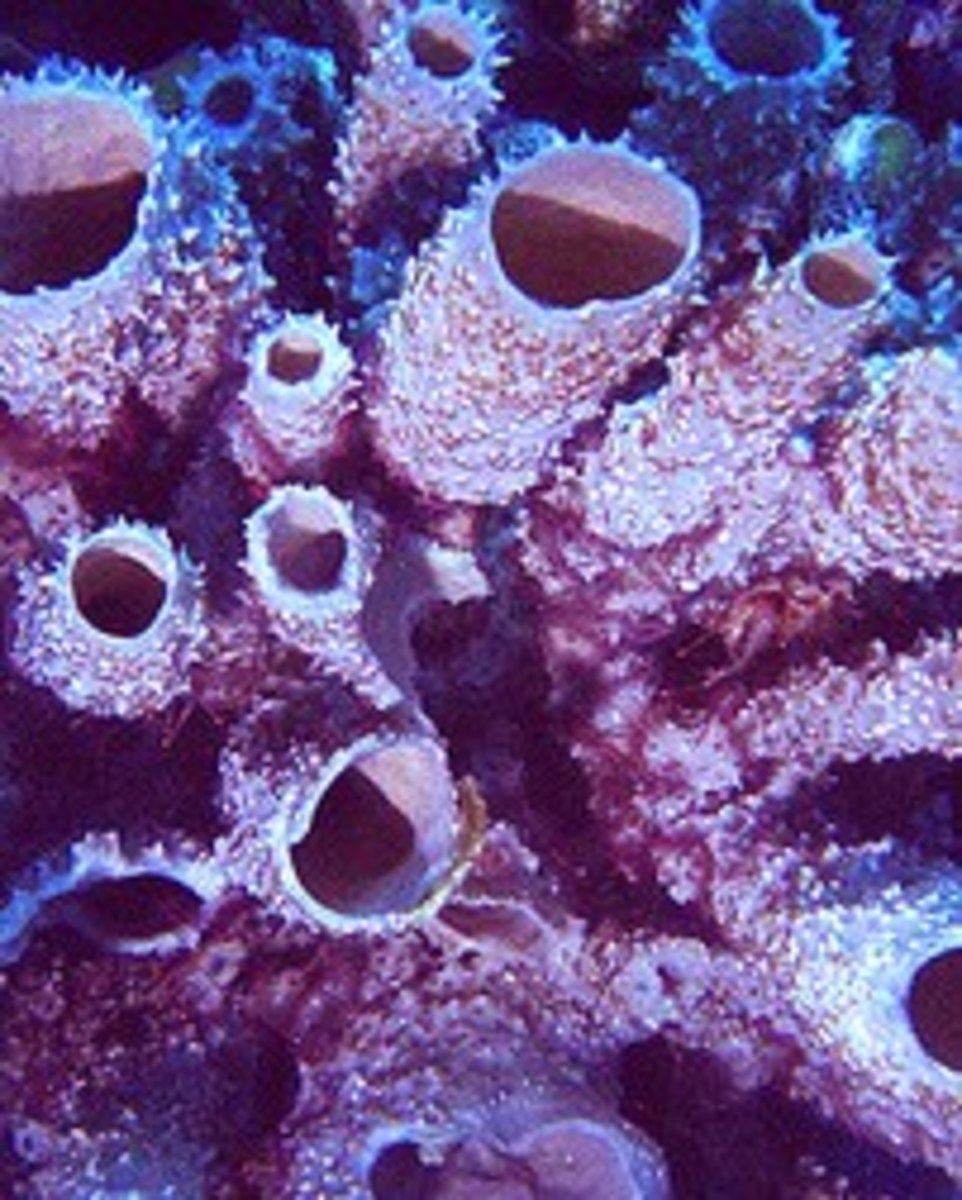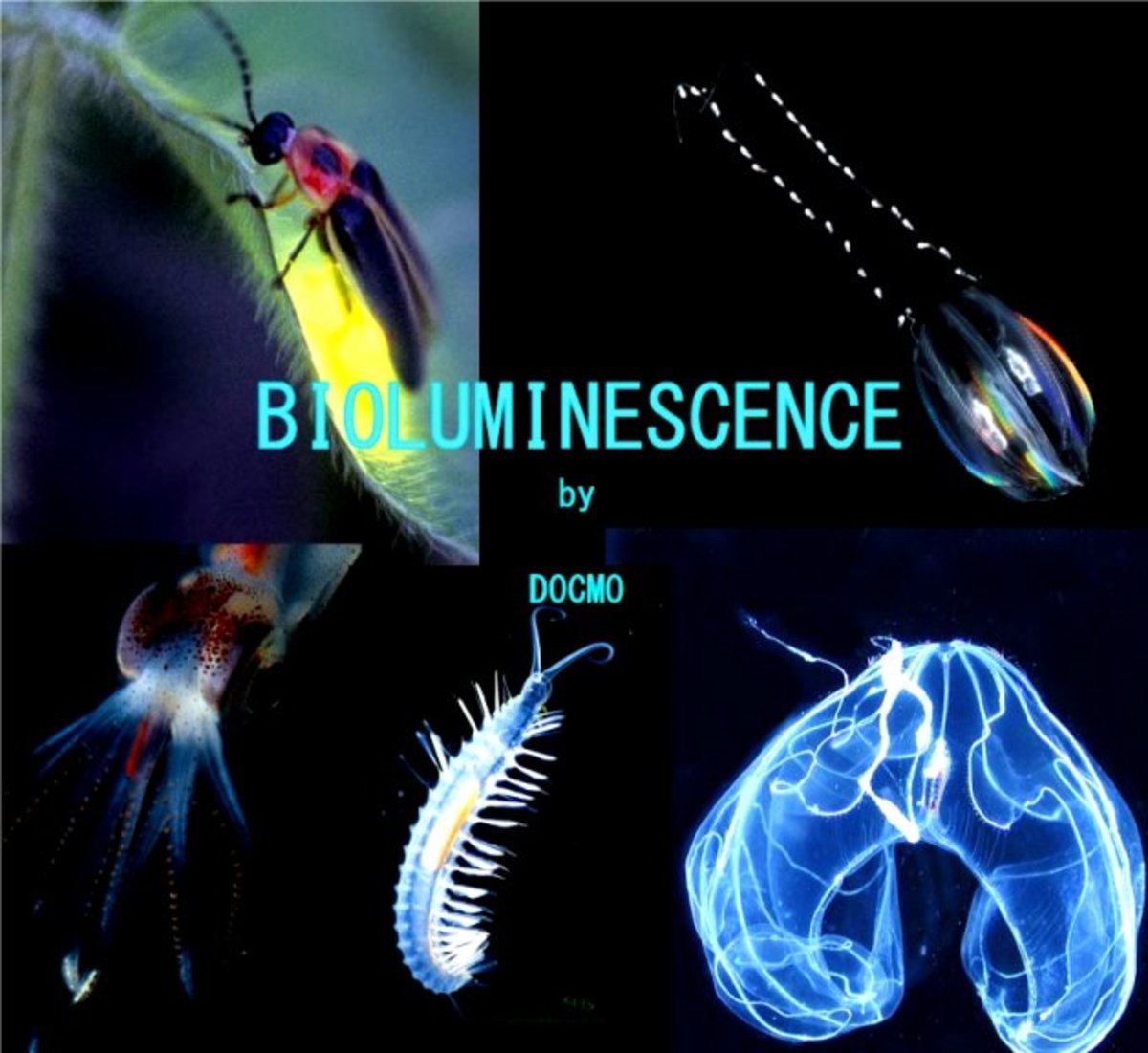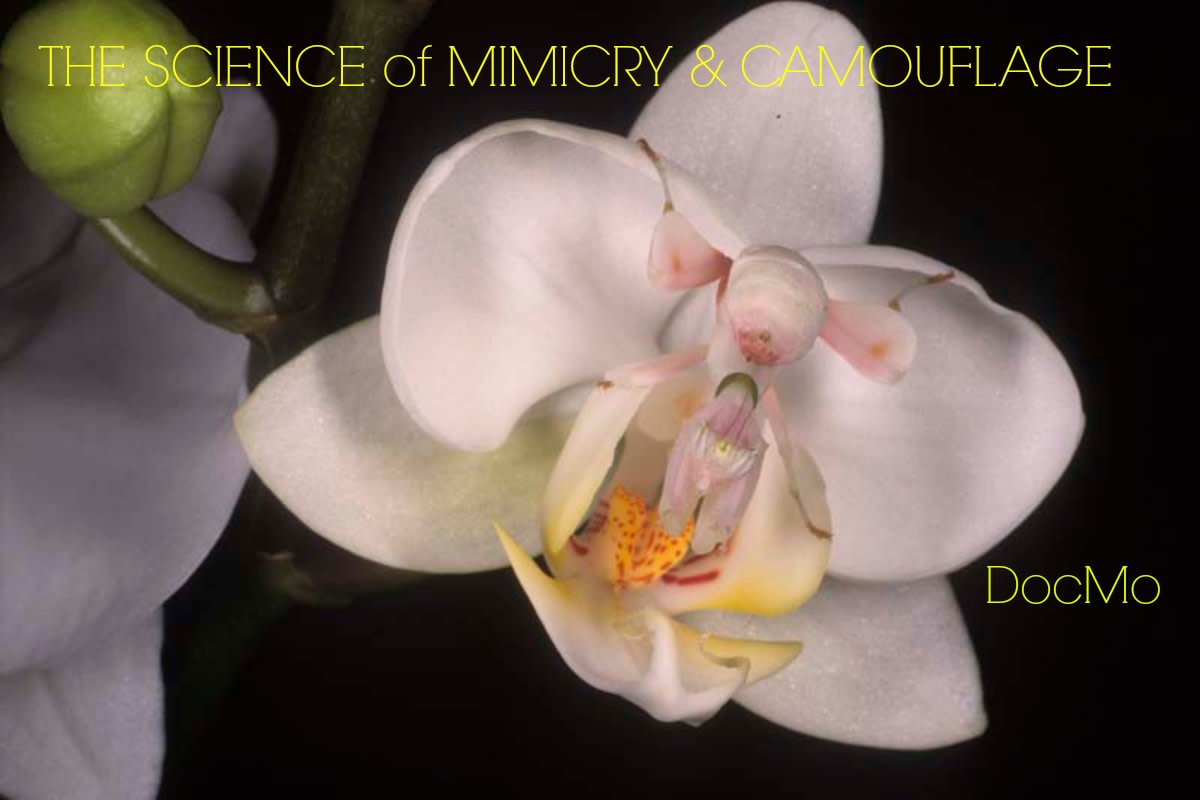The Animal Kingdom

Characteristics and Types of Animals
The Animalia Kingdom is one of 6 Kingdoms of organisms. The other 5 kingdoms are: Plantae, Fungi, Protista, Archaea and Bacteria. Like the name suggests, the animalia kingdom is made up of animals!
Animals, like the flamingo shown here, have a wide variety of characteristics. For example, animals can have 2 legs (birds), 4 legs (dogs), 5 legs (starfish), 6 legs (insects), 8 legs (spiders or octopi),...even no legs (fish)! They can have fur, feathers, scales, skin, shells, or other coverings. Some animals feed their babies milk, others do not. While many animals walk, some fly, swim, slither, or hop! But in spite of all their differences, animals also share many characteristics.
On this page, we'll explore what makes an animal an animal and learn a little about different types of animals too.
Did you know?
There are over a million different species of animals in the world!
How many can you name?
Animals share the following characteristics. - These are some of the characteristics which make an animal an animal!
- Animals are heterotrophs. That means they don't make their own food, like plants, but instead must find food to eat.
- Digestion takes place inside an animal's body. Once animals have food, they eat it and then digest it inside their bodies. Fungi, like mushrooms, do not do this. Fungi digest their food outside their bodies.
- Mobility. Animals are different from plants in that animals can move.
- Multicellularity. Animals are made up of more than one cell.
- Animals are diploid organisms. Diploid organisms are ones where the adult has 2 copies of each chromosome, but the reproductive cells have only 1 copy of each chromosome.
- No cell walls. Plants have cell walls, but animals do not. The lack of a cell wall in animals helps animals be able to move around!
Did You Know?
No matter how big or small an animal is, the cells are about the same size. In other words, your cells are about the same size as those of a rhino or a flea.
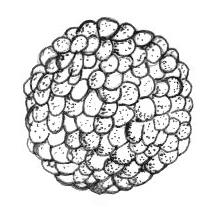
Blastula
In most animals, when an egg gets fertilized, it undergoes many cell divisions and forms a hollow ball, called a blastula.
More Characteristics of Animals
- What makes an animal an animal....
- Sexual Reproduction. Most animals engage in sexual reproduction. The egg cells of animals are larger than the sperm cells. The sperm cells get around via a flagella.
- The blastula(pictured above) develops into 2 or 3 layers of cells. These layers eventually develop into all the various types of tissues and organs of the adult body.
- The echoderm layer of the blastula develops into the sense organs, the nervous system, and the skin.
- The endoderm layer of the blastula develops into the respiratory system, the bladder, the liver, the digestive organs and the lining of the digestive tract, as well as many glands. (A gland is an organ in the body that secretes chemical substances. You can read more about glands here, if you'd like --> Glands.)
- The mesoderm layer of cells in the blastula develops into muscles, bones, reproductive organs, excretory organs (the system of the body which helps you get rid of waste), and the circulatory system. (You'll learn more about these various parts of the body in another chapter.)
- Tissues. Almost all animals have tissues. Tissues are groups of cells that work together to do a specific job. Sponges are a type of animal that do not have tissues.
Did You Know?
Your body has cells that move around in it! Your cells are not all fixed in one location!
Body Symmetry And An Animal's Body Plan:
How Symmetrical Are The Bodies Of Animals?
An animal's body plan refers to it's shape, internal organization, and type of symmetry.
Symmetry means if you were to divide the object with a line running through it, the object would be the same size and shape on both sides of the dividing line. There can also be symmetry around a central point which means if you rotate the object around it's center, it will have basically the same shape as it did before you turned up (the various legs or other appendages will line up).
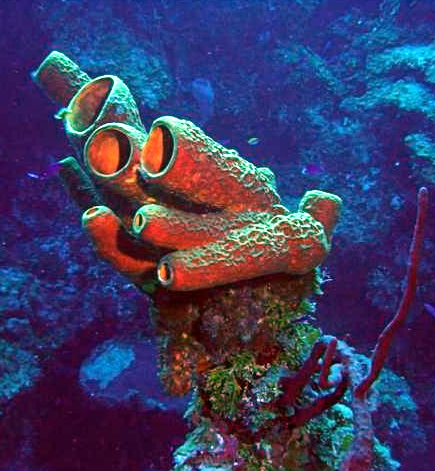
Asymmetrical
Animals that are asymmetrical don't have a regular shape. Sponges, shown here, are asymmetrical. That means they are not symmetrical.
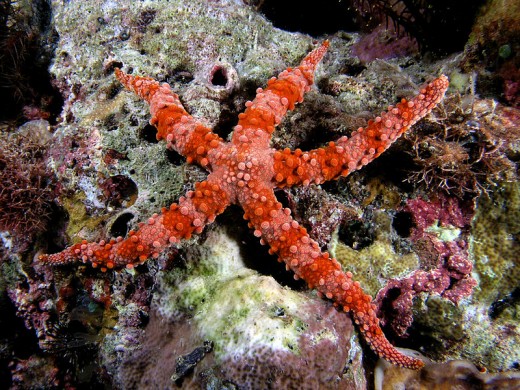
Radial Symmetry
Animals that have radial symmetry such as a starfish, have legs that come from a point in the center and branch out.
Most animals that have radial symmetry live in water and either move very slowly, or simply drift along with the water current.
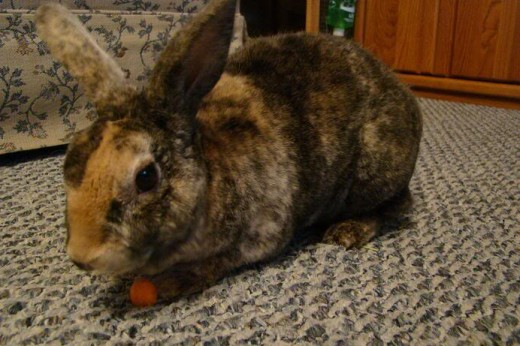
Bilateral Symmetry
Animals that have a matching right and left side of the body have bilateral symmetry. Bunnies, puppies, kittens, whales, people, and many other types of animals have bilateral symmetry.
Most animals that have bilateral symmetry also have a head on one end of them that has extra nerves in it as well as various sensory structures (sensory structures are what allow us to hear, smell, taste, see, or feel). This is called cephalization. Cephalization helps animals sense danger and find food.
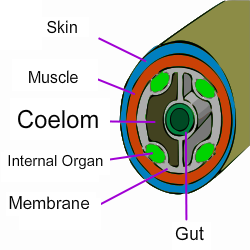
The Types of Bodies Animals Can Have
- Bodies With or Without an Coelom (An Internal Body Cavity)
Animals with bilateral symmetry have one of three types of bodies:
- Acoelomate,
- Pseudocoelomate,
- or Coelomate.
Each one of these words has the word "coelom" in it. A coelom means a body cavity or space between the digestive tract (the gut) and the body wall. Inside a coelom, body organs can move freely, grow, and develop independently from the body wall, while fluid inside the coelom cushions and protects the organs.
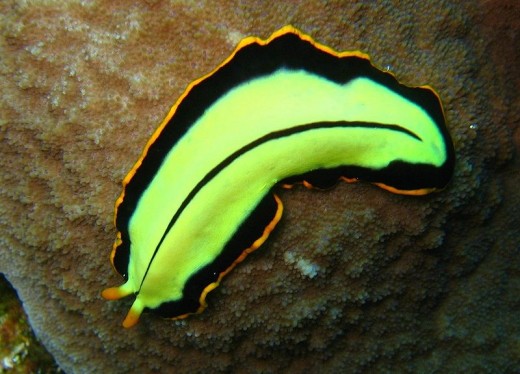
Acoelomates
Acoelomates are animals which do not have a coelom (body cavity). Instead, the space is filled with tissues.
Flatworms are an acoelomate.
Cross section of an acoelomate animal, such as a flatworm
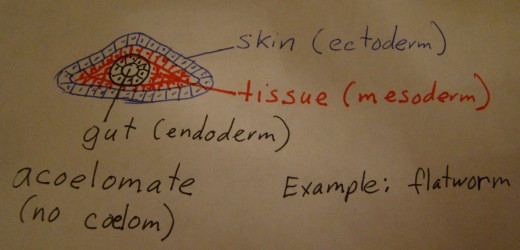
In my drawing of the cross section of an acoelomate animal (above), you can see how there are tissues between the skin and the gut. There's no space for a coelom.
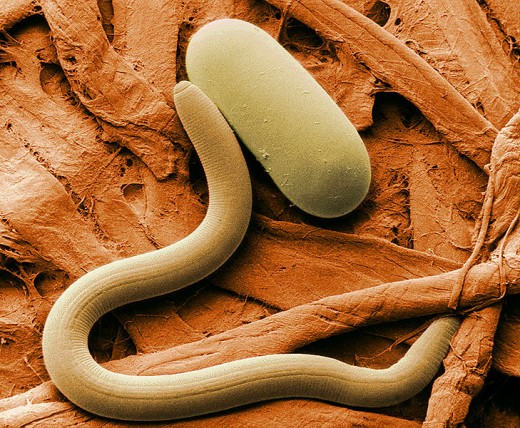
Pseudocoelomates
Pseudocoelomates are animals which have a "false coelom." This is a body cavity between the endoderm (the gut) and the mesoderm (muscle tissue).
Nematodes (roundworms) are a type of pseudocoelomate.
Cross section of a pseudocoelomate animal
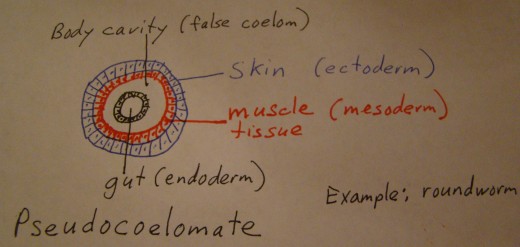
In the drawing above of a cross section of a pseudocoelomate animal, you can see that there is a cavity - a coelom - that is between the muscle tissue and the gut. It is referred to as a false coelom, rather than a true coelom, because it is not bordered on both sides by muscle tissue.
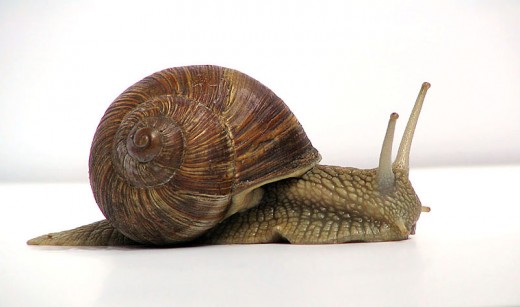
Coelomates
Coelomates are animals that have a true coelom. The body cavity is located within the mesoderm. The fluid filled coelom cushions the internal organs and allows animals to move around easily without damaging their organs.
Snails, as well as many other animals including humans, have a true coelom.
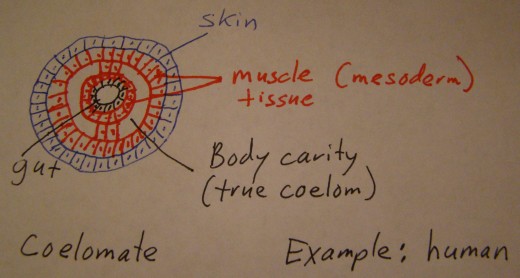
In this cross section drawing of a coelomate animal, you can see that the coelom is located between two sections of muscle tissue.
Segmented Animals
- Crustaceans, Spiders, Insects, Earthworms, and Vertebrates all have some form of segmentation during at least one stage in their life cycle.
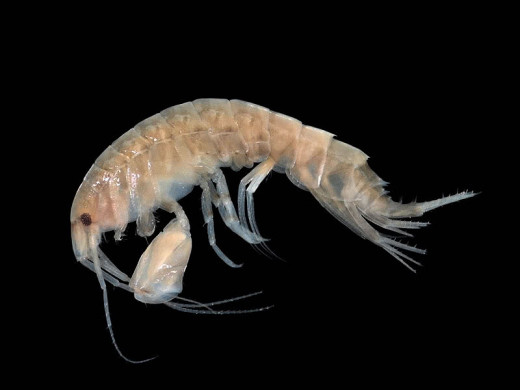
Segmented animals, like this amphipoda (above), other crustaceans, spiders, earthworms, insects, and others, have a series of similar repeating body parts.
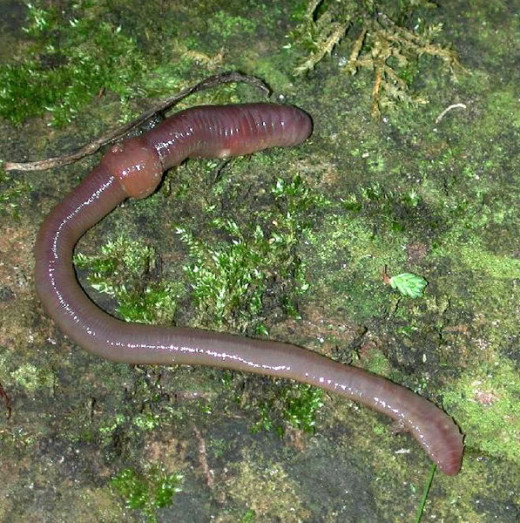
The body of earthworms is segmented. This segmentation provides for greater flexibility as the earthworm moves and burrows. Because each segment contains many of the same organs, an injured earthworm can often still carry out life functions. A circulatory system connects the segments together. Nerves also connect the segments to a brain.
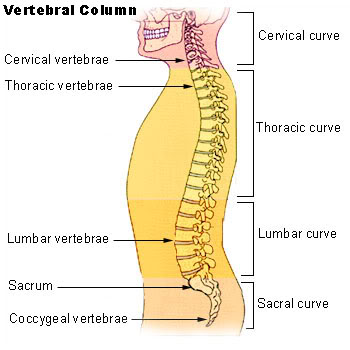
In Vertebrates, the backbone is made up of a series of very similar vertebrae.
This too is a form of body segmentation.
Invertebrates and Vertebrates:
The 2 Main Divisions Of The Animal Kingdom
The animal kingdom is often divided into two main categories: Vertebrates and Invertebrates. Vertebrates are those animals with a backbone. Invertebrates are those animals without a backbone.
Vertebrates Vs Invertebrates
Vertebrates
Vertebrates include jawless fish, bony fish, sharks and rays, amphibians, reptiles, mammals, and birds.
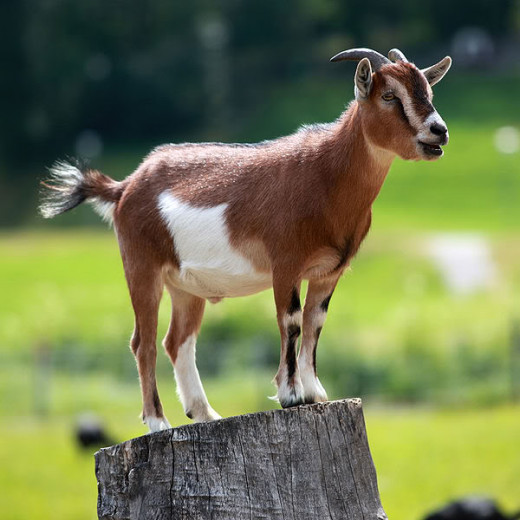
A goat is an example of a vertebrate animal because it has a backbone.
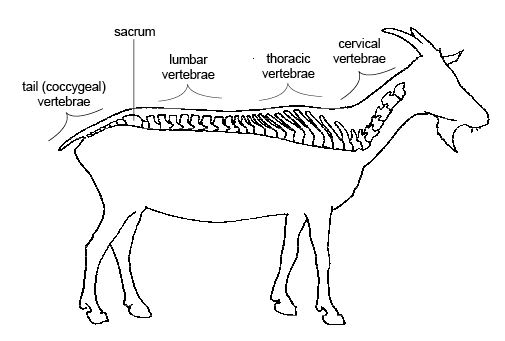
Invertebrates
Sponges, jellyfish, sea anemones, sea stars, insects, spiders, crabs, lobsters, snails, clams, squids, and many other types of animals are invertebrates.
97% of all animal species are invertebrates! Invertebrates do not have a backbone. Many invertebrates have an exoskeleton or shell instead of a backbone.
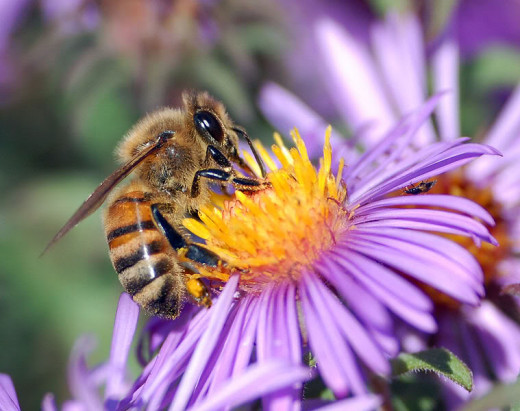
A bee is an example of an invertebrate. Instead of a backbone, a bee has an exoskeleton.
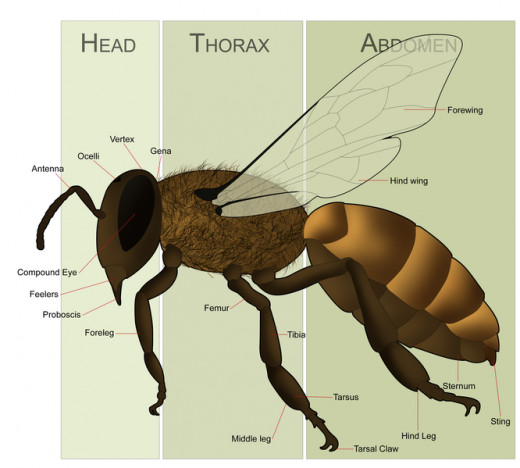
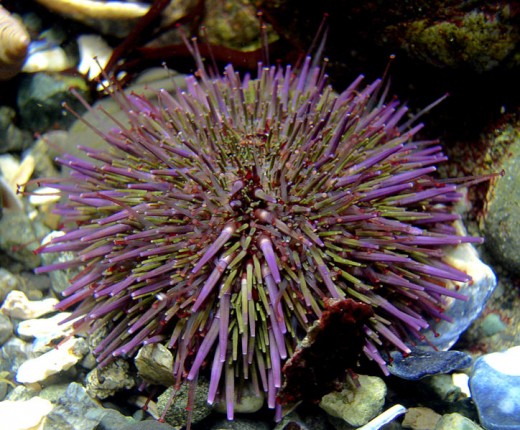
Sea Urchins are also invertebrates. Instead of a heavy backbone, a sea urchin has a porous, light-weight structure called a stereom.
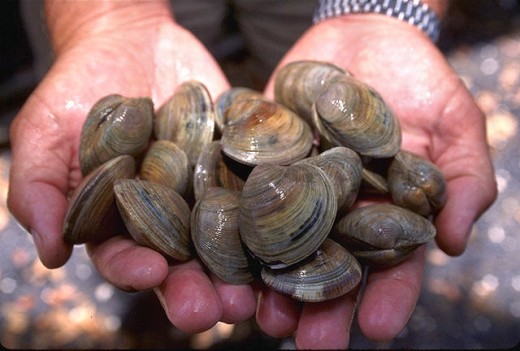
Instead of a backbone, clams have a shell, so they are invertebrates as well.
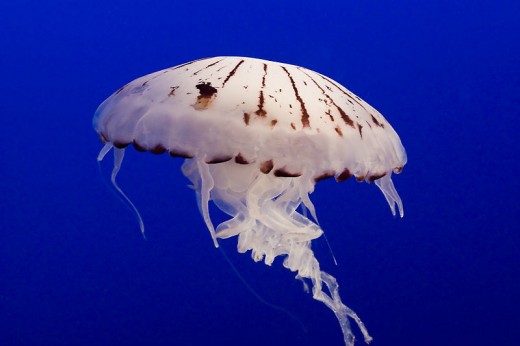
Even Moon Jellies are invertebrates! Instead of a backbone, they have a hydrostatic skeleton. A hydrostatic skeleton, found in many soft bodied animals, is made up of a fluid-filled cavity (the coelom) surrounded by muscles.
The Animal Kingdom Can Also Be Divided Into Different Phyla.
There are over 35 different phlya in the animal kingdom!
Here are a few of the phyla in the animal kingdom:
Phylum Porifera
Sponges
Phylum Porifera - Sponges
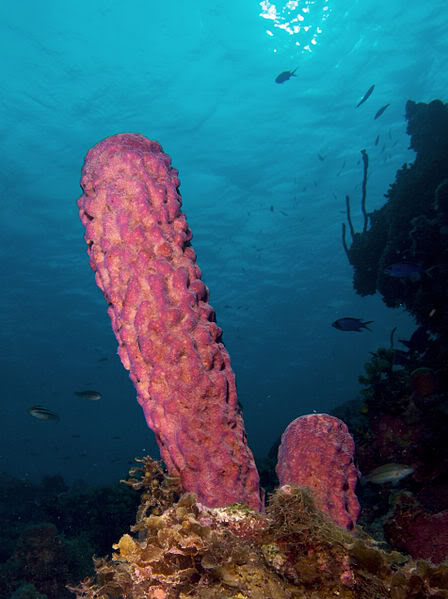
- Asymmetrical
- No tissues and organs
- Internal cavity has food-filtering cells called choanocytes
- Animals in this phylum are mostly marine animals.
- The bodies of animals in the Porifera phylum are made up of a non-living jelly-like substance (called mesohyl) which is sandwiched between two layers of cells.
- The bodies of animals in this phylum are full of pores and channels which allow water to circulate throughout them.
- There are about 9000 species of animals in the phylum Porifera.
More About Sponges
- Sponges Are Simple Animals That Live In The Sea (Or Sometimes In Fresh Water)
Sponges are simple animals which live in water. Most sponges live in the sea, but a few live in freshwater. Find out more about sponges at this website.
Phylum Cnidaria
jellyfish, sea anemones, hydra, corals, Portuguese Man o' War and more
Phylum Cnidaria - Includes about 10,000 species, including jellyfish, sea anemones, hydra, corals, and Portuguese Man o' War.
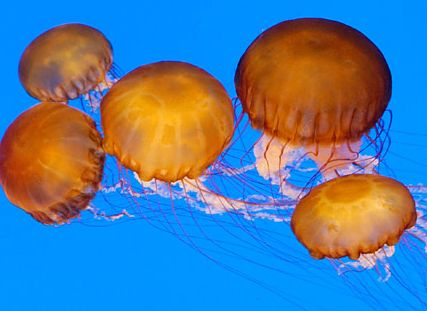
- Radially symmetrical
- Most members of this phylum have tissues
- Animals in this phylum have baglike bodies
- Gelatinous (like jelly) animals
- Live in marine or fresh water
- Have mouths surrounded by tentacles
Interesting movie about the Portuguese man o' war
Phylum Ctenophora
comb jellies and more
Phylum Ctenophora - Includes about 100 species, including comb jellies
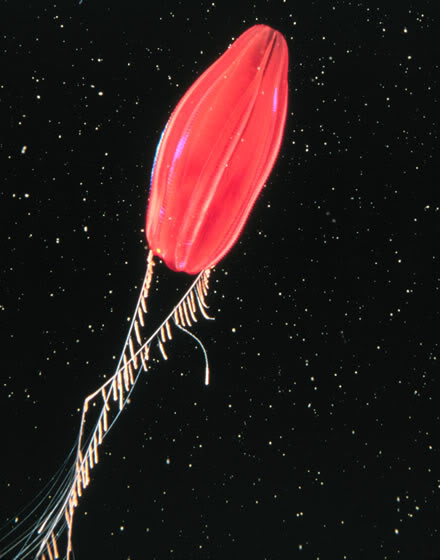
- Radially Symmetrical
- Transparent
- Gelatinous bodies (jelly like)
- Marine animals
Phylum Platyhelminthes
flatworms, tapeworms, planarians, flukes, and more
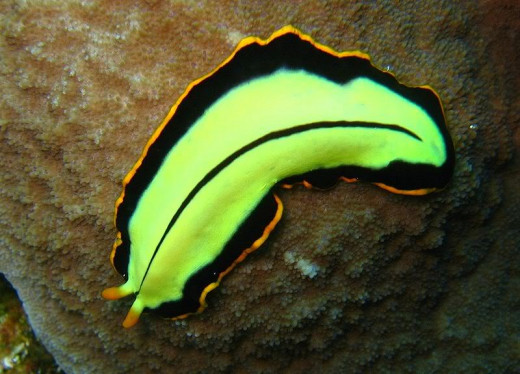
Phylum Platyhelminthes
Includes about 20,000 species, including flatworms, tapeworms, planarians, and flukes.
- Bilaterally symmetrical
- Acoelomate (no coelom)
- Flat ribbon-like bodies
- No true segments
Short Video of a Planarian moving
Phylum Nematoda
roundworms and more
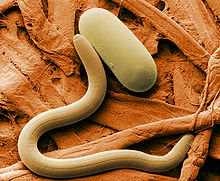
Phylum Nematoda
- More than 12,000 species, including roundworms
- Parasitic
- long, slender, unsegmented worms
- Pseudocoelomate (false coelom)
Phylum Mollusca
snails, slugs, whelks, clams, oysters, scallops, squids, octopuses, nautilus, and more
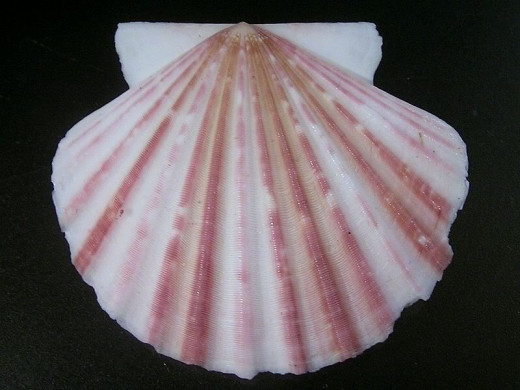
Phylum Mollusca
- About 110,000 species, including snails, slugs, whelks, clams, oysters, scallops, squids, octopuses, nautilus, and more
- Soft bodied animals
- Have a true coelom
- Have three parts to their bodies: a foot, a visceral mass, and a mantle
- Live on land or in water
Chambered Nautilus swimming in the ocean
More About Mollusks
- Mollusks Are Invertebrates
This article contains information, colorful photos, and videos of mollusks, including snails, squids, scallops, clams, cuttlefish and others.
Phylum Annelida
earthworms and leeches and more
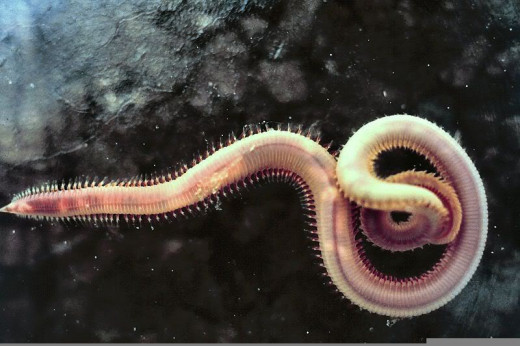
Phylum Annelida
- About 12,000 species, including earthworms and leeches
- Bilaterally Symmetrical
- Segmented Worms
More About Annelids
- Earthworms, Christmas Tree Worms, Leeches, and Other Annelids
Annelids are segmented worms including earthworms, leeches, fireworms, Christmas Tree worms, and many other species. Want to find out more about annelids?
Phylum Arthropoda
spiders, scorpions, insects, horseshoe crabs, sea spiders, and more
Phylum Arthropoda
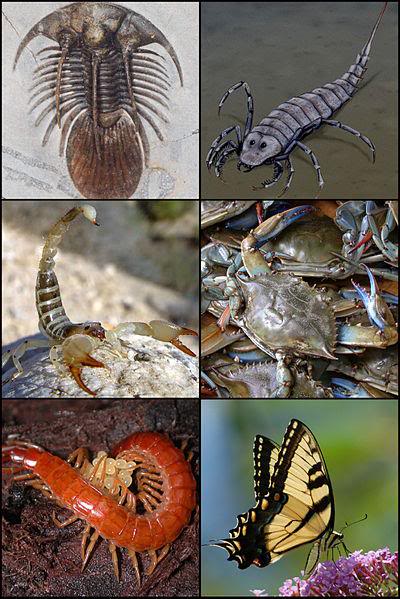
Arthropods
- About 1 million species, including spiders, scorpions, insects, horseshoe crabs, sea spiders.
- paired, jointed appendages (legs)
- bilaterally symmetrical
- Exoskeleton
- Segmented bodies
- Live in the air, on land, and in water
Scorpions
Phylum Echinodermata
sea stars, brittle stars, sea lilies, sand dollars, sea urchins, sea cucumbers and more.
Phylum Echinodermata
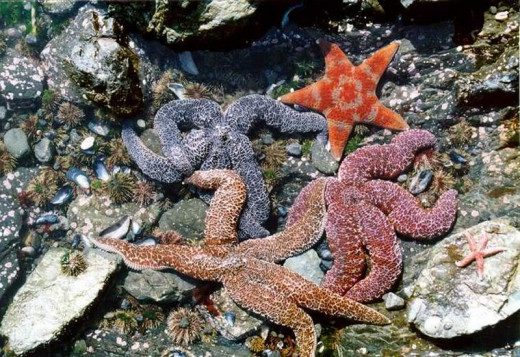
Phylum Echinodermata
- About 6,000 species including sea stars, brittle stars, sea lilies, sand dollars, sea urchins, and sea cucumbers.
- Radially symmetrical (in adult form) - with five main body parts (usually 5 arms)
- tube feet
- marine animals
Phylum Chordata
lancelets, jawless fish, sharks, rays, skates, bony fish, frogs, toads, salamanders, newts, lizards, snakes, turtles, alligators, birds, mammals, rodents, bats, duckbill platypuses, and more!
You are a member of Phylum Chordata!
Phylum Chordata
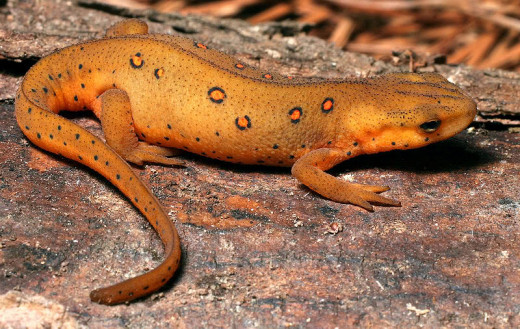
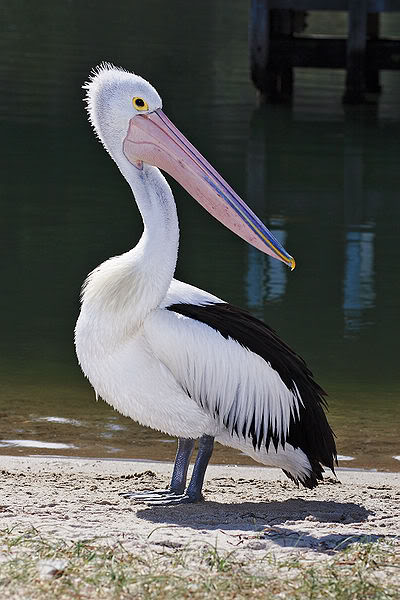
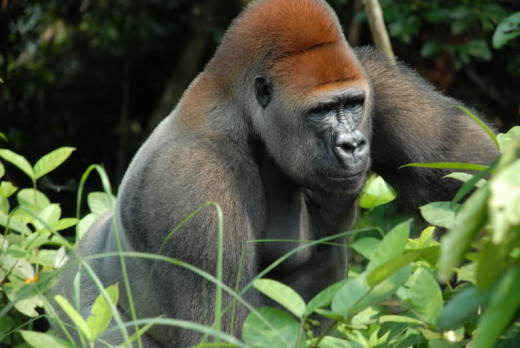
Phylum Chordata
- About 42,500 species, including lancelets, jawless fish, sharks, rays, skates, bony fish, frogs, toads, salamanders, newts, lizards, snakes, turtles, alligators, birds, mammals, rodents, bats, duckbill platypuses, and more!
- Bilaterally symmetrical
- True Coelom
- Notochord (a flexible rod shaped structure found in the embryos of all chordates)
- Live on land or in water
- Dorsal (meaning located at the back) nerve cord
Characteristics of Animals - Paul Anderson (bozemanbiology) talks to us about the characteristics of Animals.
Animal Behavior
Animals: Mammals, Birds, Reptiles, Amphibians, Fish, and Other Animals - A Class Of Their Own series

Biology
A List of Pages in This Biology Series
Homepage: Biology: Information, Videos, and Labs
Unit 1 on Cell Biology
Unit 2 on Genetics
Labs, Information, And Videos For High School Students Studying Genetics.
Unit 3 on The History of Life on Earth
Unit 4 on Ecology
Ecological Principles / Populations
Biological Communities - Symbiosis, Niches, and Biomes
Global Changes And The Environment
Unit 5 on Diversity
An Introduction to Taxonomy - The Kingdoms and Domains Of Life
Learning About Viruses And Bacteria
Protists: Paramecium, Amoebas, Algae, Diatoms, Euglena, and Others
Unit 6 on All About Plants
Unit 7 on The Animal Kingdom: Invertebrates
The Animal Kingdom - An Introduction
The Cnidarians: Jellyfish, Sea Anemones, Hydrozoans, and Corals
Earthworms, Christmas Tree Worms, Leeches, and Other Annelids
Unit 8 on Vertebrates
NEW: Fish: The Characteristics of Jawless Fish, Cartilaginous Fish, and Bony Fish
Check back later for additional biology units!

